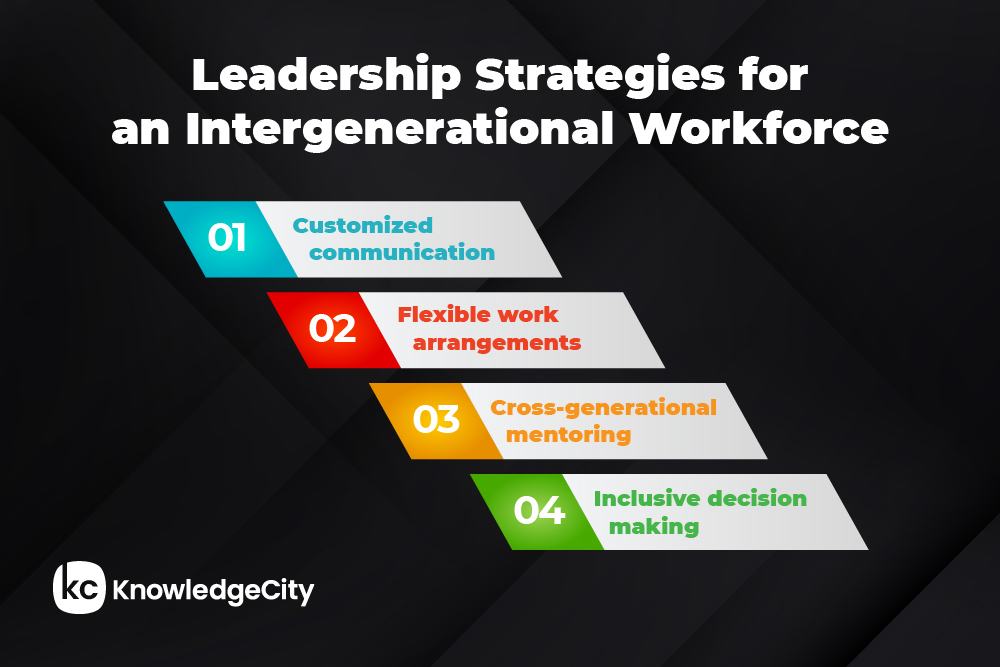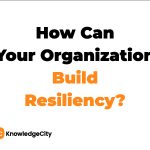Today’s corporate landscape is a mosaic of age diversity, where the seasoned experience of Baby Boomers meets the fresh innovation of Generation Z. For HR leaders and decision-makers, the challenge lies in uniting these diverse perspectives into a single, dynamic workforce.
This article explores the dynamics of an intergenerational workforce, highlights the benefits of age diversity, and provides strategies for leaders to effectively bridge the generational divide. Embracing these practices, leaders can cultivate a workplace that is not only inclusive but also primed for robust growth.

What Is an Intergenerational Workforce?
An intergenerational workforce is a fusion of different eras, each bringing its unique strengths to the corporate table. Baby Boomers anchor this diverse group with their deep industry knowledge and strong work ethic, while Generation X members apply their adaptability to serve as a bridge between established traditions and emerging technologies. Millennials champion flexibility and purpose, driving the shift toward a more integrated work-life balance and the rise of the gig economy. The newest wave, Generation Z, enters with a digital-first approach, infusing the workplace with innovative tech solutions and a strong sense of social responsibility.
The convergence of these varied generational perspectives offers experiences that can significantly enhance workplace dynamics. However, it’s not without its challenges. Differences in communication styles, work preferences, and technological adeptness can lead to friction. Traditional hierarchical models often clash with the flat, networked structures favored by the younger cohorts, necessitating a delicate balance between varying expectations and operational methodologies.
For HR leaders, the objective is to harness these diverse generational insights to create a cohesive and dynamic work environment. By doing so, they can transform potential intergenerational friction into a collaborative synergy, leveraging the full range of talents and perspectives. This not only celebrates the multiplicity of the workforce but also aligns it with the organization’s goals, driving innovation and sustainable success in an ever-evolving business landscape.
Why Is Age Diversity Important?
Age diversity is a beneficial attribute and a critical driver of organizational success. It combines the seasoned insights of older employees with the innovative approaches of younger ones, creating a dynamic environment ripe for creative problem-solving and innovation. This blend of experiences encourages a re-examination of traditional methods and the birth of groundbreaking solutions, allowing companies to challenge the status quo and stay ahead of the competition.
Reflecting a diverse customer base, an age-diverse team offers comprehensive insights into consumer needs across generations, fostering the development of products and services with wide appeal. In problem-solving, the varied perspectives lead to robust solutions, marrying the caution and experience of older workers with the fresh, tech-oriented approaches of younger staff. This yields more effective results and cultivates a culture of learning and respect.
To capitalize on this diversity, HR must foster an inclusive culture that values each generation’s contribution, promoting engagement and retention. A workplace where age diversity is celebrated can reduce turnover, increase job satisfaction, and strengthen the employer brand.
For organizations to thrive in a diverse global market, HR leaders must embrace and leverage the full spectrum of generational talent available, ensuring a dynamic, inclusive, and resilient workplace.
Benefits and Challenges of an Intergenerational Workforce
The intergenerational workforce presents a unique opportunity for organizational enrichment and innovation. The key to unlocking this potential is transforming inherent challenges into collaborative strengths.
Leadership plays a pivotal role in this transformation. By fostering an environment of cross-generational mentorship, companies can create a fertile ground for growth where the seasoned expertise of older employees synergizes with the tech-savvy approaches of younger ones. This mentorship becomes a conduit for shared knowledge, driving the company forward through stability and adaptability.
To achieve this, leaders must cultivate a culture that embraces different communication styles and work-life preferences. Organizations can mitigate friction and build a resilient, unified team by recognizing and valuing these differences and establishing shared goals and values. This approach bridges generational divides and forges a workplace where every employee, regardless of age, can thrive and contribute to the company’s success in meaningful ways.
Leading a Multigenerational Workforce: Leadership Strategies
To lead a multigenerational workforce effectively, leaders must employ strategies that are as dynamic and varied as the workforce itself. Here are specific, actionable strategies that go beyond the foundational understanding of generational characteristics:
Customized communication: Implement a communication strategy that employs a variety of channels tailored to generational preferences. For instance, while Baby Boomers may appreciate more formal communication and in-person meetings, Millennials and Gen Z might engage better with instant messaging and social media platforms. Leaders can use a mix of these methods to ensure that important messages are conveyed in a manner that resonates with everyone.
Flexible work arrangements: Develop a range of work arrangements that cater to different life stages and work styles. This could include telecommuting options for those who value work-life balance, part-time positions for semi-retired professionals, or condensed workweeks for employees pursuing further education or family time.
Cross-generational mentoring: Pair younger employees with seasoned professionals in a reciprocal mentoring program. This allows for a two-way exchange of skills and knowledge, where experienced workers can learn about new technologies and trends while younger staff gain insights into the industry and professional acumen.
Lifelong learning opportunities: Create continuous learning opportunities that are accessible to all generations. This could involve online learning platforms, workshops on emerging industry trends, or even subsidizing further education. Such initiatives should be designed to accommodate different learning styles and paces.
Inclusive decision-making: Involve employees from each generation in decision-making processes. This could be through regular focus groups, suggestion boxes, or representation on project teams. Such inclusivity ensures that diverse perspectives are considered in company decisions, fostering a sense of ownership across the workforce.
Recognition programs: Design recognition programs that celebrate a wide range of achievements, from tenure and traditional performance metrics to innovative ideas and contributions to company culture. This acknowledges the value of both experience and fresh ideas.
Career pathing: Offer varied career paths that recognize different definitions of success. Not everyone aims for the traditional climb up the corporate ladder. Some may value lateral moves or project-based work that allows them to build a portfolio of experiences.
By implementing these strategies, leaders can create a workplace where each generation’s strengths are recognized and actively driving the company forward. This approach enhances engagement and productivity and positions the organization to benefit from the full spectrum of its workforce’s capabilities.
Best Practices for Intergenerational Workforces
To effectively manage an intergenerational workforce, HR leaders should focus on crafting inclusive policies, fostering continuous learning, and ensuring clear communication. Here’s a condensed overview of these best practices:
Inclusive policies: Implement flexible working arrangements to support different life stages, such as telecommuting for work-life balance and phased retirement for older employees. These policies should reflect a commitment to supporting a diverse range of employee needs.
Continuous learning: Develop learning and development programs accessible to all employees. These should facilitate upskilling and encourage understanding across generations, promoting a collaborative and empathetic workplace culture.
Clear communication: Maintain transparent communication to ensure all employees are informed and aligned with the organization’s goals. Open channels for feedback allow for a responsive and inclusive environment where every voice can be heard.
HR leaders can reinforce a workplace culture that values respect, inclusivity, and adaptability, leveraging the strengths of a diverse workforce to drive organizational success.
Conclusion
The intergenerational workforce is a multifaceted asset that, when navigated skillfully, can become a source of enduring strength and innovation for any organization. The key takeaways for HR leaders are cultivating a culture that values each generation’s unique contributions, fostering an environment where continuous learning and flexible policies are the norms, and ensuring that communication across generational lines is clear and effective.
By strategically leveraging the diverse experiences and perspectives of all age groups, companies can enhance their problem-solving capabilities and create a more dynamic and adaptable organization. The future of business is inherently intergenerational, and the success of companies in this landscape will be defined by their ability to unite the workforce’s varied talents into a cohesive and innovative whole.
Subscribe to Our Newsletter
Join 80,000+ Fellow HR Professionals. Get expert recruiting and training tips straight
to your inbox, and become a better HR manager.

 Chuk Otakpor
Chuk Otakpor 










